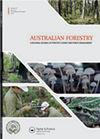在塔斯马尼亚西北部的Ferrosols上的桉树种植园比相同土壤类型的原生森林含有更多还是更少的土壤碳?
IF 0.9
4区 农林科学
Q3 FORESTRY
引用次数: 0
摘要
尽管澳大利亚大陆各州和海外的研究表明,将原生林转化为人工林可以减少土壤中的碳(C)储量,但尚未在塔斯马尼亚进行研究,以评估人工林如何影响土壤C储量。为了解决这一知识差距,我们使用析因抽样策略,比较了塔斯马尼亚州西北部Ferrosols上原生“混合”桉树林和邻近的nitens桉树种植园30厘米深度的土壤C浓度和C储量。人工林土壤C、N平均浓度显著低于混交林;但由于人工林土壤容重较高,两种处理(分别为114 Mg ha−1和116 Mg ha−1)的土壤碳储量差异不显著。结论是,在为人工林清理土地的过程中,机器将5-6厘米的表土移到窗口中,足以解释为什么人工林中的碳浓度低于混混林,而且,除了这种土地整理的物理效应外,塔斯马尼亚西北部Ferrosols上17-21年的人工林生长并没有显著影响矿物土壤中的土壤C储量。这一结果可以部分解释为铁溶胶在有机物、倍半氧化物和粘土之间形成稳定络合物的能力。本文章由计算机程序翻译,如有差异,请以英文原文为准。
Do eucalypt plantations on Ferrosols in north-west Tasmania contain more or less soil carbon than native forests on the same soil type?
ABSTRACT Although studies in mainland states of Australia and overseas show that the conversion of native forests to plantations can reduce carbon (C) stocks in soils, no studies have been undertaken in Tasmania to assess how plantations affect soil C stocks. To address this knowledge gap, we compared soil C concentrations and C stocks to 30 cm depth in native ‘mixed’ eucalypt forests and adjacent Eucalyptus nitens plantations on Ferrosols in north-west Tasmania, using a factorial sampling strategy. Mean soil C and nitrogen (N) concentrations were significantly lower in plantations than in mixed forests; however, because the soils in plantations had higher bulk density, mean soil C stocks under the two treatments (114 Mg ha−1 and 116 Mg ha−1, respectively) were not significantly different. It is concluded that machine removal of 5–6 cm of topsoil into windrows during land clearing for plantations would be sufficient to explain why C concentrations were lower in plantations than in mixed forests and that, apart from this physical effect of land preparation, 17–21 years of plantation growth on Ferrosols in north-west Tasmania has not significantly affected soil C stocks in mineral soil. This result can be partly explained by the ability of Ferrosols to form stable complexes between organic matter, sesquioxides and clays.
求助全文
通过发布文献求助,成功后即可免费获取论文全文。
去求助
来源期刊

Australian Forestry
FORESTRY-
CiteScore
3.70
自引率
4.80%
发文量
15
审稿时长
>12 weeks
期刊介绍:
Australian Forestry is published by Taylor & Francis for the Institute of Foresters of Australia (IFA) for scientific, technical, and professional communication relating to forestry in the Asia Pacific.
 求助内容:
求助内容: 应助结果提醒方式:
应助结果提醒方式:


